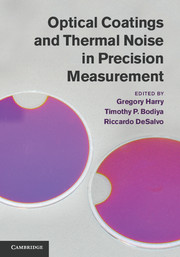Book contents
- Frontmatter
- Contents
- List of contributors
- Foreword
- Preface
- 1 Theory of thermal noise in optical mirrors
- 2 Coating technology
- 3 Compendium of thermal noises in optical mirrors
- 4 Coating thermal noise
- 5 Direct measurements of coating thermal noise
- 6 Methods of improving thermal noise
- 7 Substrate thermal noise
- 8 Cryogenics
- 9 Thermo-optic noise
- 10 Absorption and thermal issues
- 11 Optical scatter
- 12 Reflectivity and thickness optimization
- 13 Beam shaping
- 14 Gravitational wave detection
- 15 High-precision laser stabilization via optical cavities
- 16 Quantum optomechanics
- 17 Cavity quantum electrodynamics
- References
14 - Gravitational wave detection
Published online by Cambridge University Press: 05 January 2012
- Frontmatter
- Contents
- List of contributors
- Foreword
- Preface
- 1 Theory of thermal noise in optical mirrors
- 2 Coating technology
- 3 Compendium of thermal noises in optical mirrors
- 4 Coating thermal noise
- 5 Direct measurements of coating thermal noise
- 6 Methods of improving thermal noise
- 7 Substrate thermal noise
- 8 Cryogenics
- 9 Thermo-optic noise
- 10 Absorption and thermal issues
- 11 Optical scatter
- 12 Reflectivity and thickness optimization
- 13 Beam shaping
- 14 Gravitational wave detection
- 15 High-precision laser stabilization via optical cavities
- 16 Quantum optomechanics
- 17 Cavity quantum electrodynamics
- References
Summary
Introduction
Some of the most energetic and intriguing phenomena in our universe, including black hole coalescence and the first moments of the Big Bang, cannot be observed with traditional “light telescopes”. These events can only be “seen” with gravitational wave observatories that detect minute ripples in the fabric of space-time. Gravitational wave detection has the potential to open a new window for humanity to view and understand the universe. However the experimental requirements for detection are extreme and meeting the sensitivity limits has spurred research in noise reduction. The study of thermal noise in optical coatings was driven by the need formirror displacement sensitivities of 10-19 min advanced gravitational wave interferometers (Levin, 1998; Harry and The LIGO Scientific Collaboration, 2010; Harry et al., 2002).
Einstein's General Theory of Relativity states that an accelerating mass will produce a gravitational wave. The acceleration produces a distortion in space-time that propagates at the speed of light (see Einstein (1915), Einstein (1916), and Barish and Weiss (1999)). Gravitational waves interact extremely weakly with matter and as a result are very difficult to detect. Thus, an astrophysical event is required to produce gravitational waves that are strong enough to be detected on Earth. These weakly interacting waves are rarely scattered or absorbed, therefore the information they carry is virtually unaltered regardless of the time and distance they have traveled to us or the intervening objects and conditions they have encountered.
- Type
- Chapter
- Information
- Optical Coatings and Thermal Noise in Precision Measurement , pp. 216 - 236Publisher: Cambridge University PressPrint publication year: 2012

